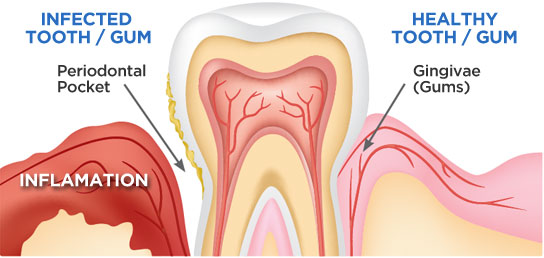Gum disease is a term used for an infection that occurs in the bones and tissues that are around the teeth. Another term for it is periodontal disease. There are two classifications for gum disease: gingivitis and periodontitis. Gingivitis is a type of gum disease that only affects the gums, while periodontitis is a more severe form of gum disease. Periodontitis goes deeper than the surface and cause damage to the bone and tissues that provide support for your teeth.
Causes
Gum disease often occurs when germs, or bacteria grows on the teeth and gums. Plaque contains a certain amount of bacteria. When the bacteria present in plaque comes in contact with sugars contained in the foods you eat they form toxins. These can irritate your gums which causes swelling and bleeding when they are brushed. Over time, plaque hardens and forms tartar which can cause even more irritation to your gums and they begin to pull away from the teeth.
Risk Factors
There are some risk factors that can make you more susceptible to developing gum disease. These include:
- Failure to maintain good oral hygiene on a regular basis
- Using any type of tobacco
- Other people in your family have gum disease
- Medical conditions that weaken your immune system (AIDS, leukemia or diabetes)
- Failure to eat a healthy diet with adequate vitamins and minerals
Symptoms
When your gums are healthy they look pink and remain firm, don’t bleed easily and fit up snug to the teeth. Each type of gum disease has its own set of symptoms. The signs of gingivitis include:
- Swollen, tender or red gums
- Bleeding while brushing or flossing
Gingivitis is not very painful and sometimes symptoms are overlooked and no treatment is sought. The symptoms of periodontitis are more apparent and include:
- Gums that are pulling away from the teeth
- Persistent bad breath
- Pus coming out of the gums
- An obvious change in the way you bite felt in the way the teeth fit together
- Teeth that become loose
Treatment Options
The most important goals of treatment of gum disease are to help the gums reattach to the teeth, reduce the risk of infection, reduce swelling, and stop the progression of the disease. Markham Dental professionals choose treatment options based on the severity and stage of gum disease, how your body responded to treatments earlier, and the state of your health. Options include nonsurgical therapy to control the growth of bacteria to surgical procedures that restore the supportive tissues.
Can You Prevent Gum Disease?
In most cases, gum disease can be revered when plaque is controlled. Controlling plaque includes professional cleanings and regular brushing and flossing. Brushing helps eliminate plaque and keep it from building up on the surface of your teeth, flossing helps to remove food particles between the teeth so they do not contribute to plaque buildup between the teeth or under the gum. Antibacterial mouth washes can help reduce bacteria that lead to plaque buildup and gum disease.


